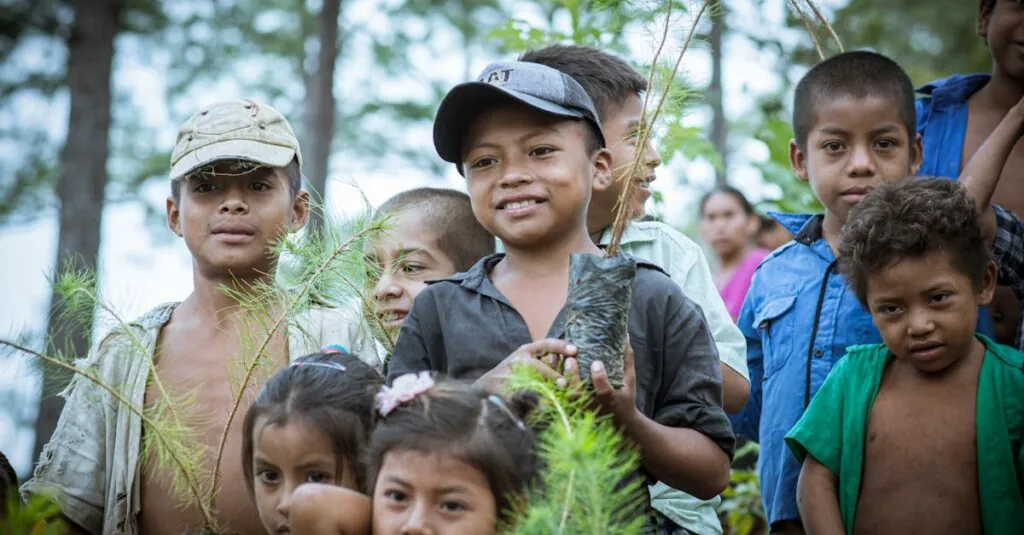Table of Contents
ToggleGuatemala’s culture is a vibrant tapestry woven from ancient Mayan traditions and modern influences. From colorful textiles to mouthwatering cuisine, this Central American gem offers a feast for the senses. If you think of Guatemala as just another stop on the tourist map, think again—this country is bursting with surprises that’ll make you want to pack your bags and book a one-way ticket.
Overview of Guatemala Culture
Guatemala’s culture showcases a blend of ancient Mayan heritage and modern influences. This diverse cultural landscape contributes to vibrant traditions, art, and social practices. Inhabitants celebrate various festivals that highlight indigenous beliefs and Catholic influences.
Textiles represent a crucial aspect of Guatemalan identity. Communities hand-weave intricate fabrics, using bold colors and traditional patterns. These textiles often carry symbolic meanings, reflecting local history and values. For example, garments like huipiles are specific to each community, indicating social status and cultural background.
Cuisine also plays a significant role in shaping Guatemala’s culture. Traditional dishes such as tamales, pepian, and kak’ik offer flavors that reflect indigenous and Spanish roots. Ingredients like corn, beans, and peppers serve as staples in everyday meals. Seasonal celebrations often feature unique dishes, emphasizing the nation’s agricultural bounty.
Language diversity enriches the cultural tapestry as well. Spanish serves as the official language, yet over 20 Mayan languages are actively spoken. This linguistic variety reflects the country’s cultural richness and contributes to its unique identity.
Art forms, including pottery, painting, and music, deeply express Guatemala’s heritage. Many artisans use traditional techniques to create unique pieces that tell stories of family, traditions, and history. Various musical styles, such as marimba, integrate indigenous and European melodies, providing a lively backdrop to celebrations.
Altogether, Guatemala’s culture exemplifies a vibrant blend of historical significance and modern expression. Each element, from textiles to food, weaves together a rich cultural narrative that captivates both locals and visitors alike.
Traditional Clothing
Traditional clothing in Guatemala reveals the country’s rich heritage, combining vivid colors and intricate designs that reflect local customs and social status. These garments tell stories of the past, connecting present generations to their ancestors.
Indigenous Attire
Indigenous attire forms a significant part of Guatemala’s cultural identity. Women commonly wear traje, a colorful ensemble comprised of a woven blouse known as huipil and a skirt called corte. Each garment varies by region, showcasing unique patterns and styles. Men often don camisas and pantalones, made from handwoven fabric, which emphasize traditional craftsmanship. The use of natural dyes enhances the vibrancy of these textiles, ensuring their cultural significance remains intact.
Modern Influences
Modern influences have started to shape traditional clothing in Guatemala. Urban areas see a mix of contemporary styles blended with indigenous elements, particularly among younger generations. Fashion designers increasingly incorporate traditional textiles into modern outfits, bridging the gap between heritage and modernity. This fusion not only preserves cultural identity but also promotes the craftsmanship of local artisans. With globalization, traditional clothing adapts while maintaining its historical roots, reflecting a dynamic cultural landscape.
Food and Culinary Traditions
Guatemalan cuisine showcases a rich blend of flavors, reflecting the country’s diverse cultural heritage. Traditional recipes often connect indigenous ingredients with Spanish influences.
Popular Dishes
Tamales represent a staple dish, featuring masa filled with various ingredients like meats, vegetables, or fruits. Pepian serves as another signature dish, characterized by a hearty stew made from chicken or beef and a colorful array of vegetables and spices. Kak’ik, a traditional turkey soup, utilizes tomato and achiote for its distinct red hue. Each dish highlights the culinary fusion that defines Guatemalan cooking. Street food options, such as pupusas and tostadas, offer quick, flavorful meals that locals and visitors enjoy alike.
Culinary Ingredients
Corn stands as the foundation of Guatemalan cuisine, appearing in various forms like tortillas and tamales. Beans add protein and are commonly featured in everyday meals, enhancing nutritional value. Chiles contribute spice and depth, while herbs like cilantro and epazote introduce fresh flavors. Additionally, fruits such as mangoes, papayas, and avocados play a crucial role in both savory and sweet dishes. Traditional spices, including cumin and allspice, provide unique taste profiles that elevate the culinary experience.
Music and Dance
Guatemalan culture vibrates with traditional music and intricate dance forms that reflect its diverse heritage. Music serves as a vital expression, connecting communities through various genres.
Traditional Music Genres
Mariachi boasts its presence in celebrations, showcasing lively melodies and spirited performances. Garifuna music, rooted in African and Caribbean traditions, combines drumming and singing, creating a unique auditory experience. Traditional Mayan music features instruments like marimbas and flutes, vital in rituals and festivities. Folk music amplifies storytelling, preserving regional histories and fostering community ties. These genres demonstrate a rich cultural blend, echoing Guatemala’s complex past and vibrant present.
Dance Forms
Folkloric dance captivates audiences with colorful costumes and rhythmic movements. Traditional dances, like the “Baile del Venado,” narrate tales of nature and spirituality. The “Danza de los Moros y Cristianos” depicts the historical encounters between indigenous civilizations and Spanish conquerors. Each dance symbolizes cultural pride, celebrating local traditions through physical expression. Many performances occur during festivals, fostering community identity and continuity of customs. These dance forms embody the spirit of Guatemala, illustrating its rich cultural narrative.
Language and Dialects
Guatemala’s linguistic landscape is a vibrant tapestry, incorporating both Spanish and various indigenous languages. This diversity reflects the country’s rich cultural heritage and historical influences.
Spanish Influence
Spanish serves as the official language, spoken by approximately 93% of the population. This widespread use stems from the Spanish colonization in the 16th century, when the language began to integrate into local customs. Spanish is not only the medium of government and education but also permeates everyday communication across urban centers. Despite this dominance, it coexists harmoniously with indigenous languages, showcasing a unique bilingual experience for many citizens. Its presence significantly shapes Guatemalan literature and media, creating a dynamic cultural discourse that resonates throughout the country.
Indigenous Languages
Over 20 indigenous languages enrich Guatemala’s cultural fabric, with K’iche’, Q’eqchi’, and Kaqchikel being the most prominent. These languages carry deep historical and cultural significance, often tied to specific regions and communities. Approximately 40% of the population speaks an indigenous language, with many bilingual speakers navigating both Spanish and their native tongue. Each language embodies unique traditions, folklore, and collective identities. Various cultural programs promote the preservation of these languages, encouraging younger generations to embrace their linguistic heritage. Efforts toward bilingual education further enhance intercultural dialogue and understanding in this diverse nation.
Festivals and Celebrations
Guatemala’s festivals and celebrations showcase the country’s vibrant cultural tapestry. These events blend ancient customs with modern influences, offering rich experiences for locals and visitors alike.
Major Cultural Festivals
Major festivals reflect Guatemalan heritage and community spirit. Semana Santa, or Holy Week, features elaborate processions, intricate carpets made of colored sawdust, and stunning religious imagery. The Feria de la Independencia takes place every September and celebrates national pride with parades, music, and traditional food. La Fiesta de Todos Santos honors the Day of the Dead in early November, combining indigenous rituals with Catholic traditions. Each festival illustrates the significance of community, faith, and cultural identity in Guatemala’s society.
Rituals and Traditions
Rituals and traditions play a crucial role in daily life across Guatemala. Mayan ceremonies often include offerings to the Earth, honoring ancestors and indigenous beliefs. The celebration of San Simon involves music, dance, and rituals to seek blessings for prosperity and health. New Year’s Eve sees the creation of effigies, called “Año Viejo,” which symbolize the old year’s burdens. These practices highlight the connection between past and present, maintaining a rich cultural legacy that continues among diverse communities.
Guatemala’s cultural landscape is a vibrant tapestry woven from its ancient Mayan roots and modern influences. The fusion of traditional practices with contemporary styles creates a unique identity that captivates visitors and locals alike. From the intricate textiles to the rich culinary traditions and lively festivals, each aspect reflects a deep connection to history and community.
The enduring spirit of Guatemala shines through its art, music, and dance, offering a glimpse into the heart of its people. As travelers explore this dynamic culture, they’ll discover not just a destination but a living heritage that continues to evolve while honoring its past. Embracing Guatemala’s cultural richness promises an unforgettable experience that resonates long after the journey ends.




